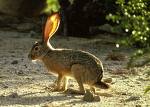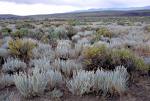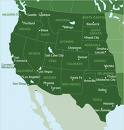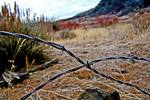|
AMS 105- American West: Images and Identities |
|
A. Jackrabbits, Sagebrush, and the 98th Meridian

White Tailed Jackrabbit (Lepus townsendii) |

Great Basin Sagebrush (Artemisia tridentata) |

98th Meridian |
Historians described the American West as European Americans moved across the continent. The frontier line and what was the West changed from the early 1800s at the Appalachian Mountains and in 100 years reached the Pacific Coast. Early writers in the 1820s-1840s like James Fenimore Cooper, Washington Irving and Francis Parkman wrote of more Eastern Midwest regions as the frontier and the West. From 1880-1920 the subfield of American History of the American West and Western Historiography emerged. Two prominent American historians noted two unique aspects of the American experience; 1) the effect of the American Frontier on American character and 2) the effect of the American West’s arid environment on American immigrant settlers.
1) At the 1893 World Columbian Exposition in Chicago Frederick Jackson Turner (1861-1932), a University of Wisconsin history professor, gave a paper to a group of colleagues on "The Significance of the Frontier in American History". It took a number of years for this paper to generate an impact. Its significance was marked by the U.S. Census Bureau in 1890 declaring the disappearance of a contiguous frontier line in the American West. Turner noted this ‘closing of the frontier’ as significant and reflected on the unique influence of that frontier on the American psyche. Turner’s thesis has flaws but established recognition of American traits of individualism, ingenuity and pragmatism. Earlier, Alexis de Tocqueville observed similar characteristics of Americans in his work Democracy In America (1835-40), but Turner brought a more serious examination of these characteristics and their origins. The American frontier is more variable and complex than Turner proposed. For instance, individuals had to depend on family and community to ultimately thrive. Turner ignored American Indians and their influence. In truth American Indian cultures were highly individualistic, yet family and clan were essential for cooperation. Diverse skills and ingenuity were greatly needed to survive in tough environments, including threats by outside invaders. The early American pioneers, out of necessity, emulated these American Indian traits of individualism coupled with local group cooperation. In later times Americans had to unite for common causes and perceived threats to the entire nation. Turner also failed to recognize that for many cultural groups and for women the Frontier and the American West was often a dismal experience of subjugation and deprivation. The imagery of the American West, depending on one's point of view, continues to influence and haunt Americans. Often perceived values derived from biased and simplified interpretations of the experience of the American West are used for selfish purposes or to influence others. Such powerful imagery was exploited and exaggerated in early ‘dime’ novels and stage shows like Buffalo Bill’s Wild West Show.
As the American Frontier line moved across the Mississippi beyond the 'Gateway Arch' in today’s St. Louis, Missouri, the American Frontier moved further into the Plains and Far West. Today, foreign travelers are astounded by the open space, distance and immensity of the American West. Foreign travelers still ride buses, trains or rental cars to journey across America. In the Plains it is common to be asked by foreign travelers in Kansas, "how far is it to Los Angeles." When informed that is more than 1,000 miles or 2 days driving it produces a reaction of awe and disbelief.
2) In 1922, Walter Prescott Webb (1888-1963), a University of Texas history professor, had an epiphany while trying to access what made the American West unique. He began to realize that the geographic shift from Woodland forest and prairie to the semi-arid and treeless plains was a shift in the physical geography that had a significant and dramatic impact on people. This shift was more specifically one from the tallgrass praire to the shortgrass praire (Great Plains). In the Dakotas, Nebraska and Kansas one can see the shift driving from east to west along the I-90, I-80, I-70 right in the middle of these states. The grasses change and other creatures follow with cottontails replaced by jackrabbits, etc. as you go west.
W.P. Webb realized these changes occurred around the 98th Meridian from North Dakota through South Dakota, Nebraska, Kansas, and Oklahoma to Texas. This area was called the "Great American Desert" by pioneers who could not initially cope with the desert and went on to California and Oregon on the great wagon roads like the Oregon Trail (1840). Eventually the "Great American Desert" was referred to as the "Great Plains" and people settled it. However, people had to change to adapt to the arid and treeless expanse of the Plains. The horse, new guns, cattle, barbed wire, sod houses, windmills, and dry farming were all adaptations to settling the arid American West. The eastern slope of the Rocky Mountains was a formidable environment, and pioneers eventually went on and settled the western slope of the Rockies to the Pacific slope (120°), which was an even harsher desert (Intermountain or Great Basin). Most of the settlement of the American West came after 1840 and really exploded after the Civil War (1865). This of course was preceded by Spanish exploration and settlement into the American West as well as exploration by early French, English, Russian and American fur trappers.
When post Civil War pioneers first came to settle the American West, especially the Great Plains they found that old ways and technologies of the Eastern Woodlands did not work.
|
Old Way |
Change |
|
Old crops withered and died |
Had to develop irrigation techniques & new hybrids |
|
Water travel not practical in shallow Western Rivers |
Horses, then railroad replaced water travel |
|
Wood/stone houses impractical since no wood/stone |
Initially pioneers built sod or adobe houses |
|
Fences-no wood, open range |
Open range; eventually barbwire introduced |
|
Fresh food and available water |
Dried and barbequed food, spices; less water windmills and drilling |
|
English /cavalry boots and saddle |
Spanish vaquero (Western) boots and saddle |
|
Weapons: Kentucky rifle, single shot |
Sharps-long range 600 yards, Colt revolver and Winchester repeating rifle/carbine. |

Also, after the Civil War when more settlers began to sink roots in the Plains and American Indian tribes still occupied the Plains regions and were hunting bison or farming. As the Army was called back to the Plains (>1865) to subdue these groups such as the Cheyenne, Sioux, Kiowa and Comanche it became clear that the Plains Indians were superior horsemen and fighters. General Sherman decided that the same strategy used against Confederate soldiers (CSA), which was to destroy their of logistical base on his march from Atlanta to the sea, was needed to defeat the Plains Indian. Therefore, the American Army sought to destroy the staple for most Plains Indians, the American Buffalo or Bison
It is estimated that there were 60 million bison at the time of European contact (~1830) in the Great Plains area. There were still 15 million in 1870 in two great herds. With the help of the Sharps rifle, with a range of 600 yards, the U.S. Army and private hunters like Buffalo Bill Cody were able to all but exterminate the Bison by 1885. In turn this forced surviving Plains tribes to come onto the reservations. As the Plains people were reduced and moved onto the reservations, settlers, sodbusters, sheepherders, and cattlemen settled the American West. The Indian and Cowboy essentially never fought each other as portrayed in the Wild West Shows or film. The cows and cowboy replaced the buffalo and Plains Indian. Even John Wayne in many of his later films correctly portrayed the cowboy/cattleman era as after the Indian era in the Red River area of Texas (filmed in Mexico). Yet, in the 1950’s and even today toy stores sell plastic ‘Cowboy and Indian’ Ft. Apache sets.
However, the American West from the 98th Meridian to the Pacific Coast was and is more than just the Eastern slope of the Rockies and the Great Plains. Its overwhelming characteristic of aridity was dominant, except for the Far Western Pacific slope with a great temperate rainforest from the California redwoods to British Columbia. Thus, the American West was made up of many different sub-regions with unique challenges for the original Native Americans and later American pioneers.
Next: I-B. Regional Definitions
Back To Main Page
Copyright © S. J. Crouthamel 2013